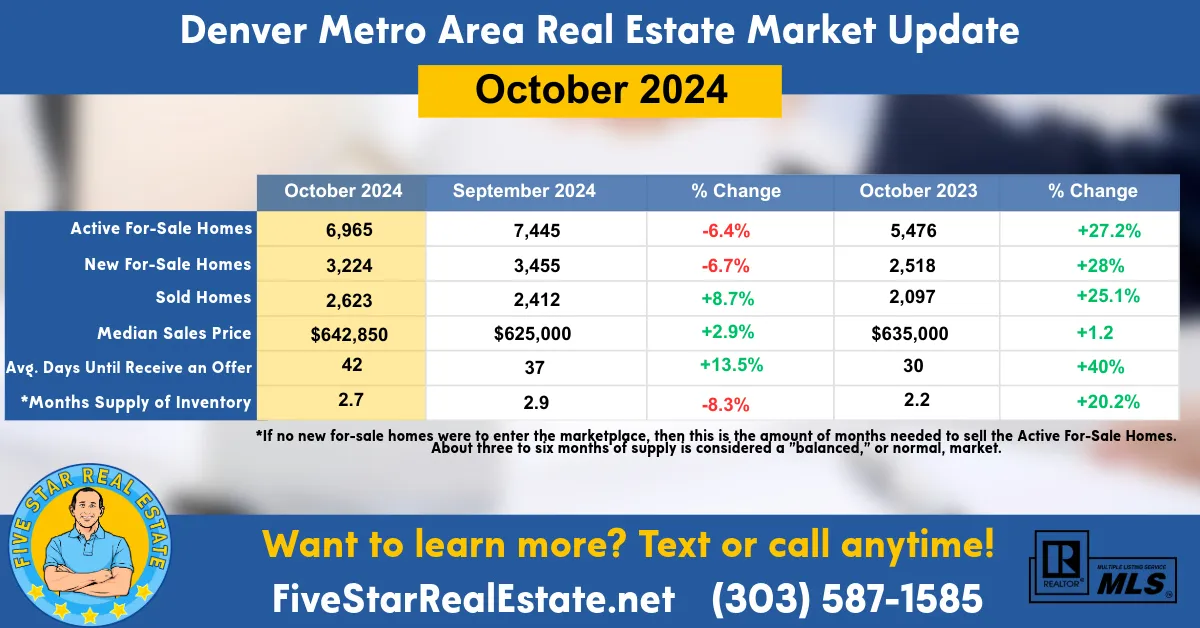Realtor Brad Dunevitz
Five Star Real Estate Colorado


303-587-1585
Just A Call Or Text Away!
Five Star Real Estate Blog
Blog

Metro Denver Market Update October 2024
Market Overview
Three factors contributed to the Denver real estate market’s activity:
The last Friday of October, a popular day for closings, experienced a notable increase in finalized transactions in the Denver real market, as buyers and sellers hurried to complete deals.
Halloween weekend slightly shifted attention away from real estate activity.
Impending elections — and especially this one — seem to introduce a degree of caution among buyers and sellers, with many of them awaiting the outcome, resulting in a slight dip in new listings and contracts.
Collectively, these influences highlight the sensitivity of the market to timing and external events, shaping a dynamic period for metro Denver’s real estate landscape.
2024 Versus a Few Years Ago
Although many people label the 2024 Denver real estate market — especially when comparing it to 2019 through 2022 — as “poor” or “bad” or “super slow,” it’s actually a more-normalized market with hot and cool areas and with the majority of homes receiving an offer within 30 to 60 days, as opposed to 30 to 60 hours!
Inventory and Negotiating Power
Inventory levels remained relatively stable during October, yet inventory is the highest it’s been since 2013. This translates into buyers having more negotiating power and choices.
Buyers are asking for — and often are getting — seller concessions, which are seller-paid closing costs. Higher interest rates have contributed to buyers asking for these concessions, which help buyers pay for some or all of their closing costs. And sellers have been agreeing to these requests, especially if they make the difference between selling or not selling their home.
Sales and Prices
The number of homes that closed during October — 2,623 — increased by 8.7% compared to the previous month. The median home price increased by 2.9% to $642,850, which is 1.2% higher than October 2023’s median price of $635,000.
Accurate Pricing Matters
Pricing a home at or below market value is so important, instead of pricing it above market value, allowing for “wiggle room,” and dropping the price to where it should have been but then dealing with the stigma of a “stale” listing.
Repeat from the last six months: I've noticed a healthy amount of all properly priced single-family homes have received an offer or multiple offers within their first week on the market. Meanwhile, many of the other for-sale homes have lingered on the market for 30 and up to 100 days. Again, the proper listing price and specific location — city, zip code, or neighborhood — matter.
My Monthly Mantra
I believe Months Supply of Inventory is a true yardstick of the real estate market. A "balanced" market has at least three months and up to six months of supply available. In other words, if, starting today, no sellers were to list their home for sale, then — according to the definition of a balanced market — all the for-sale homes would sell in three to six months.
That figure was 2.7 months in October. Thus, our supply of inventory remained much higher (20.2%) than it was in October 2023, meaning we’re near a balanced market.
Tidbits
Average and median days on market increased, with homes taking longer to sell than in recent years. The average number of days to receive an offer was 42, up from 37 days in September 2024 and 30 days in September 2023.
The number of closed transactions increased by 8.7% last month; meanwhile, the number of pending transactions also increased last month.
In September and August, the amount of pending transactions decreased, which signified that although homes were going under contract, many buyers terminated the contract, for such reasons as their loan didn’t materialize and that both parties couldn’t resolve home inspection items.
Note: Days on market can be skewed by how the MLS processes new-construction homes.
Home Seller Request
Home Buyer Request

© 2025 by Five Star Real Estate